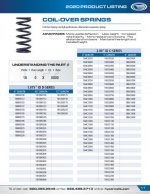Ok, I've searched and found lots of conjecture and lots of discussion but very little hard data on the 'occasional two up rear shock'. The basics seem to be that the shock is the same as the stock f3 shock, but it has a different spring. You can't order the spring separately, so you're stuck shelling out $200 for the set. Which I did. I then immediately took it apart and took measurements.
Stock spring:
Free Length 10.75" installed length 10"
Coil diameter 3.5"
Wire diameter .440"
Active coils 5
387 lb/in
2-up spring:
Free Length 10.75" installed length 10"
Coil diameter 3.5"
Wire diameter .520
Active coils 8
496 lb/in
The calculations came from racingsuspensionproducts.com
I haven't started searching yet, but with this info it should be fairly simple to buy a spring and swap it yourself for less than the $200. Another data point is that the springs are slightly tapered at the top and bottom, with the 2-up measuring around 2.825 at the ends. Should mean that a standard 2.75" spring should fit, but that's another math thing where you have to figure out the coil's inside diameter and make sure it's larger than the shock body, which is 1.85"
Discuss.
Oh yeah, I should point out that the 10.75" free length is a red herring. The shock only has a couple inches of travel so you could easily get a shorter spring and install a spacer.
Stock spring:
Free Length 10.75" installed length 10"
Coil diameter 3.5"
Wire diameter .440"
Active coils 5
387 lb/in
2-up spring:
Free Length 10.75" installed length 10"
Coil diameter 3.5"
Wire diameter .520
Active coils 8
496 lb/in
The calculations came from racingsuspensionproducts.com
I haven't started searching yet, but with this info it should be fairly simple to buy a spring and swap it yourself for less than the $200. Another data point is that the springs are slightly tapered at the top and bottom, with the 2-up measuring around 2.825 at the ends. Should mean that a standard 2.75" spring should fit, but that's another math thing where you have to figure out the coil's inside diameter and make sure it's larger than the shock body, which is 1.85"
Discuss.
Oh yeah, I should point out that the 10.75" free length is a red herring. The shock only has a couple inches of travel so you could easily get a shorter spring and install a spacer.

